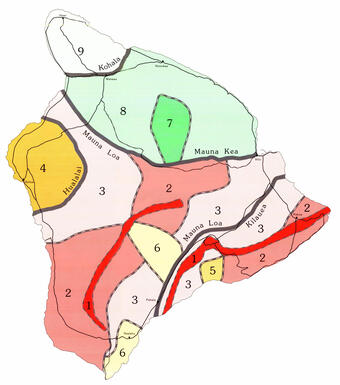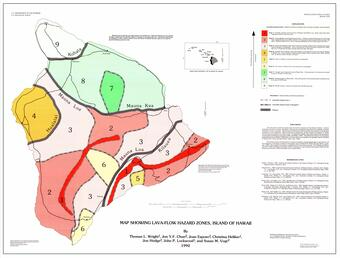Blog > Lava Zones Big Island of Hawaii
Buying Real Estate in Hawaii's Lava Zones: Are You Prepared for the Heat?
The Big Island of Hawaii is a beautiful place to live or vacation. However, it’s important to understand the different lava zones when purchasing real estate. There are nine different lava zones, ranging from Zone1, which is the most hazardous, to Zone9, which has the lowest risk.
More information about Lava Zones can be found at USGS
So, what does this mean for home buying? First and foremost, it’s crucial to be aware of the lava zone in which the property is located. This can affect your ability to get a mortgage and your insurance rates. For example, if the property is in Zone1, it may be difficult to get a mortgage or insurance due to the high risk of lava flow.
Zone 1
Includes summits and rift zones of Kilauea and Mauna Loa, where vents have been repeatedly active in historical time
Zone 2
Areas adjacent to and downslope of zone 1. Fifteen to twenty-five percent of zone 2 has been covered by lava since 1800, and 25 to 75 percent has been covered within the past 750 years. Relative hazard within zone 2 decreases gradually as one moves away from zone 1.
Zone 3
Areas less hazardous than zone 2 because of greater distance from recently active vents and (or) because of topography. One to five percent of zone 3 has been covered since 1800, and 15 to 75 percent has been covered within the past 750 years.
Zone 4
Includes all of Hualalai, where the frequency of eruptions is lower than that for Kilauea or Mauna Loa. Lava coverage is proportionally smaller, about 5 percent since 1800, and less than 15 percent within the past 750 years.
Zone 5
Area on Kilauea currently protected by topography.
Zone 6
Areas on Mauna Loa protected by topography.
Zone 7
Younger part of dormant Mauna Kea. 20% of area was covered by lava in the past 10,000 years.
Zone 8
Remaining parts of Mauna Kea. Only a few percent of area has been covered by lava in the past 10,000 years.
Zone 9
Kohala volcano, last erupted over 60,000 years ago.

If you’re looking to buy in a lava zone, it’s important to do your research and consult with a knowledgeable real estate agent. They can help you understand the risks and what it means for your investment.
In addition to the lava zones, there are other factors to consider when buying real estate on the Big Island. The market has been steadily increasing in recent years, with a shortage of available properties driving up prices. It’s important to work with a real estate agent who understands the market and can help you find the perfect property for your needs and budget.
In conclusion, the lava zones on the Big Island of Hawaii are an important consideration when buying real estate. It’s essential to be aware of the risks and work with a knowledgeable agent to make an informed decision. With the right research and guidance, you can find the perfect property and enjoy all that the Big Island has to offer.

Brought to you by Jennifer Bien,
Search Hawaii Island Real Estate
Contact Me: 808-938-3052 or jenniferlbien@gmail.com

